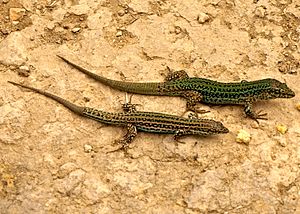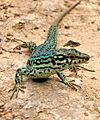Ibiza wall lizard facts for kids
Quick facts for kids Ibiza wall lizard |
|
|---|---|
 |
|
| Conservation status | |
| Scientific classification | |
| Genus: |
Podarcis
|
| Species: |
pityusensis
|
The Ibiza wall lizard (Podarcis pityusensis) is a small lizard that lives mainly on the islands of Eivissa and Formentera. These islands are part of the Balearic Islands in Spain. Sometimes, these lizards are also found in other parts of Spain because people have moved them there.
One special type of this lizard, called P. pityusensis formenterae, lives only on Formentera and nearby small islands like Illa Conillera and Es Vedrà. This type often has brighter colors than the lizards found on Ibiza or the mainland.
Contents
What Does the Ibiza Wall Lizard Look Like?
The Ibiza wall lizard is a small reptile. It can grow up to about 7 centimeters (almost 3 inches) long from its nose to the start of its tail. But most adult lizards are a bit smaller. Its tail is usually about twice as long as its body!
This lizard has a strong body with a short head. Its scales are a bit rough and slightly ridged. The top of its body is usually green, but it can also be grey or brownish. Often, there's a clear pale stripe along its sides. Sometimes, you might see a line of dark spots or a dark line running down its back.
The lizard's belly is usually white, cream, grey, orange, or pink. Its throat, and sometimes its belly, might have darker spots.
Where Do Ibiza Wall Lizards Live?
The Ibiza wall lizard naturally lives on the islands of Ibiza and Formentera in the Balearic Islands, along with the small rocky islands nearby. People have also introduced them to other places, like Muella de Palma in Mallorca and parts of Barcelona. They were even "re-discovered" in Barcelona in 2007 after people thought they had died out there. You can also find them in Aleria in southern Spain and on Gaztelugatxe island in northern Spain.
These lizards can live in many different places, from sea level up to about 475 meters (1,558 feet) high. They often live in areas with plants, especially near people. This includes gardens, fields, and farms. They also live on rocks, particularly near the coast. On some tiny islands, they are very common and live almost entirely on rocks.
What Do They Eat and How Do They Reproduce?
What Do Ibiza Wall Lizards Eat?
Ibiza wall lizards mostly eat small invertebrates, which are tiny creatures without backbones. They eat a lot of ants when ants are available. They also eat plants, especially during the summer months.
Life Cycle and Reproduction
Female Ibiza wall lizards usually lay one clutch of eggs at a time. Each clutch has one to four eggs. After a few weeks, the eggs hatch. The baby lizards are about 3.2 centimeters (1.3 inches) long when they hatch. They grow up quickly and can have their own babies when they are about one and a half or two years old.
What is Their Conservation Status?
The Ibiza wall lizard is not currently in a big decline, and it doesn't face many major threats across all its habitats. However, the total area where it lives is less than 5,000 square kilometers (about 1,930 square miles). Because of this, the IUCN (International Union for Conservation of Nature) lists it as "Near threatened". This means they are doing okay for now, but their situation needs to be watched carefully.
Recently, these lizards have faced a new problem: invasive snakes. These snakes came to Ibiza from mainland Spain, often hidden in imported olive trees. These snakes are a threat to the lizards.
Gallery
See also
 In Spanish: Lagartija de las Pitiusas para niños
In Spanish: Lagartija de las Pitiusas para niños
- The Italian Wall Lizard, a related species






